GRASS mailing list community evolution: Difference between revisions
mNo edit summary |
|||
| (One intermediate revision by the same user not shown) | |||
| Line 5: | Line 5: | ||
==Introduction== | ==Introduction== | ||
During the [http://gfoss2009.crs4.it/ 10th GRASS GFOSS User meeting] in Cagliari, Italy, a summary | During the [[https://web.archive.org/web/20130323193917/http://gfoss2009.crs4.it/ 10th GRASS GFOSS User meeting] in Cagliari, Italy, a summary | ||
of the activities of the Italian GFOSS community was presented. | of the activities of the Italian GFOSS community was presented. | ||
Together with basic indicators on the activity of the Italian | Together with basic indicators on the activity of the Italian | ||
| Line 15: | Line 15: | ||
software user meetings, we considered the idea of replicating the same analysis | software user meetings, we considered the idea of replicating the same analysis | ||
on two other mailing lists with a much longer history, namely the | on two other mailing lists with a much longer history, namely the | ||
grass developer ([ | grass developer ([https://lists.osgeo.org/pipermail/grass-dev/ grass-dev]) and the grass user ([https://lists.osgeo.org/pipermail/grass-user/ grass-user]) mailing lists. | ||
The outcome of the analysis provides a unique insight on the dynamics | The outcome of the analysis provides a unique insight on the dynamics | ||
| Line 27: | Line 27: | ||
SHORT STORY ABOUT LONG CONVERSATION (uh, could be better title) | SHORT STORY ABOUT LONG CONVERSATION (uh, could be better title) | ||
Members of the US Corps of Engineers (US Army CERL) launched the grass-user and grass-dev "GRASShopper" mailing lists in December 1991 ("Opening Night" in [ | Members of the US Corps of Engineers (US Army CERL) launched the grass-user and grass-dev "GRASShopper" mailing lists in December 1991 ("Opening Night" in [https://lists.osgeo.org/pipermail/grass-dev/1991-December/000002.html grass-dev] and [https://lists.osgeo.org/pipermail/grass-user/1991-December/013383.html grass-user]). And the first user message came from Politecnico di Milano in Italy... Only the following year the [https://lists.osgeo.org/pipermail/grass-dev/1992-January/000031.html comp.infosystems.gis] Usenet group was born, followed with a GRASS mailing lists-Usenet interface in [https://lists.osgeo.org/pipermail/grass-dev/1992-December/000584.html December 1992]. | ||
* new mailing lists born in 1999 at University of Hannover by [[user:neteler|MN]] | * new mailing lists born in 1999 at University of Hannover by [[user:neteler|MN]] | ||
| Line 110: | Line 110: | ||
== Trivia == | == Trivia == | ||
Already in early days GRASS developers were concerned about copyright issues and introduction of [ | Already in early days GRASS developers were concerned about copyright issues and introduction of [https://lists.osgeo.org/pipermail/grass-dev/1992-March/000155.html non-free code] in GRASS. The GRASS FTP site was changed to a 24hs service in [https://lists.osgeo.org/pipermail/grass-dev/1992-September/000490.html September 1992]. We remember that there was no WWW at all in those days. First GRASS Linux binaries where announced in [https://lists.osgeo.org/pipermail/grass-dev/1994-February/001430.html February 1994]. A first European GRASS FTP mirror site appeared in [https://lists.osgeo.org/pipermail/grass-dev/1995-January/001962.html January 1995]. The first internet viruses were discussed in [https://lists.osgeo.org/pipermail/grass-user/1995-April/023391.html April 1995] and first spam reached the lists in [https://lists.osgeo.org/pipermail/grass-dev/1995-October/date.html October 1995] (most spam was later manually removed from the list archives by MN). With CERL winding down the development in 1996 due to a governmental decision, the traffic in the developers ist went down to a minimum. | ||
The GRASS project returned to real activity in 1997. A first attempt to get GRASS into Debian in [ | The GRASS project returned to real activity in 1997. A first attempt to get GRASS into Debian in [https://lists.osgeo.org/pipermail/grass-dev/1998-March/002357.html March 1998]. The new GRASS 4.2.1 package, the first release after 4.1 from CERL became available in [https://lists.osgeo.org/pipermail/grass-dev/1998-January/002335.html January 1998]. The license change to GPL was discussed in [https://lists.osgeo.org/pipermail/grass-dev/1999-October/date.html October 1999]. GRASS 5 beta releases came out in [https://lists.osgeo.org/pipermail/grass-dev/1999-October/012816.html October 1999]. In 2006 a GRASS Wiki was started (originally TWIKI at [https://web.archive.org/web/20071119014748/http://grass.gdf-hannover.de:80/wiki/Main_Page https://grass.gdf-hannover.de/wiki/], then [https://lists.osgeo.org/pipermail/grass-announce/2006-May/000014.html in 2006 migrated to Mediawiki], eventually [https://lists.osgeo.org/pipermail/grass-announce/2008-April/000043.html in 2008 to moved to OSGeo] at https://grasswiki.osgeo.org/). The mailing lists were [https://lists.osgeo.org/pipermail/grass-announce/2007-November/000036.html migrated in 2007] from ITC-irst, Trento/Italy, to OSGeo, USA. | ||
... | ... | ||
| Line 122: | Line 122: | ||
== Ideas == | == Ideas == | ||
Consider watching the ML using https://github.com/elationfoundation/openThreads | Consider watching the ML using https://github.com/elationfoundation/openThreads | ||
(See: | (See: https://www.slideshare.net/apw217/sotm-openthreadsfinal for an introduction to the project) | ||
[[Category: Community]] | |||
[[Category: Promotion]] | |||
Latest revision as of 16:40, 25 April 2024
Watching how grass-dev develops (and grass-user is used)
DRAFT - work in progress - by A Giacomelli and M Neteler
Introduction
During the [10th GRASS GFOSS User meeting in Cagliari, Italy, a summary of the activities of the Italian GFOSS community was presented. Together with basic indicators on the activity of the Italian community, some simple yet intriguing statistics, derived from an analysis of the main discussion mailing lists were shown. (DARE DUE esempi SU QUESTO).
In the typical brainstorming atmosphere which permits events such as software user meetings, we considered the idea of replicating the same analysis on two other mailing lists with a much longer history, namely the grass developer (grass-dev) and the grass user (grass-user) mailing lists.
The outcome of the analysis provides a unique insight on the dynamics of the user and developer communities, over an extremely long time span, from 1991 through 2008.
How source data was collected
The story of the creation of a seventeen-year long archive of communications deserves some description, as it is representative of the effort spent in maintaining a historical record of the communications within developers (and users) through various phases of the GRASS project.
SHORT STORY ABOUT LONG CONVERSATION (uh, could be better title)
Members of the US Corps of Engineers (US Army CERL) launched the grass-user and grass-dev "GRASShopper" mailing lists in December 1991 ("Opening Night" in grass-dev and grass-user). And the first user message came from Politecnico di Milano in Italy... Only the following year the comp.infosystems.gis Usenet group was born, followed with a GRASS mailing lists-Usenet interface in December 1992.
- new mailing lists born in 1999 at University of Hannover by MN
- in 2001 lists migrated to Italy with MN and server migration
- missing emails recovered from dejanews and merged into original lists mbox files (which MN received from US Army)
- All email headers for many years had to be reconstructed since their format was broken. Painful yet rewarding.
- complete archive restored and online (~2005, check date MN)
- in 2007, lists migrated to OSGeo infrastructure
Analysis Methodology
The information extraction approach used leans on the KISS side: the core of the parsing is handled by a perl script, while the remaining post processing is carried out via standard queries and no-nonsense charting tools.
Time and space
The first core set of information extracted was the time zone reference of the messages, considering that time zone may be used to provide an approximate indication of longitude.
One of the drivers for our analysis was also to verify if/how the mailing lists provided an evidence of the shift of development activity from the initial US-based model to Europe, rather than providing a detailed spatial distribution of the developers or the users. This insured that simply considering the time zone reference would be an adequate proxy of location for the source of a given message.
For the grass-dev list, the results we obtained from a first pass with the scripts developed was able to parse correctly over 99% percent of the messages. It may be possible to obtain a greater completeness by refining the parsing algorithm to handle exceptions encountered in the process, but we considered the level of approximation obtained in the extraction of the time zone reference to be adequate for the quality objectives of our analysis.
For the grass-user mailing list, the number of messages with time zone not identified by the first pass of the parsing algorithm is higher (some 3%), but still considered satisfactory within the scope of the current analysis.
What do time and time zones tell
The charts (include numbers) show:
- absolute number of message postings by time zone and year (Figures 1 and 4, respectively for GRASS-dev and GRASS-user)
- the relative proportion of messages posted each year from a given time zone (Figures 2 and 5, respectively for GRASS-dev and GRASS-user)
- the cumulated proportion of messages deriving from different time zones, calculated assuming 100% to be the e-mail traffic generated from the beginning of the mailing list records through 2008 (Figures 3 and 6, respectively for GRASS-dev and GRASS-user)
- Figure 7: local time of posting on grass-dev: shows that most of the communication is done on business hours (and some in the evening)
(mettere qui vari spunti)
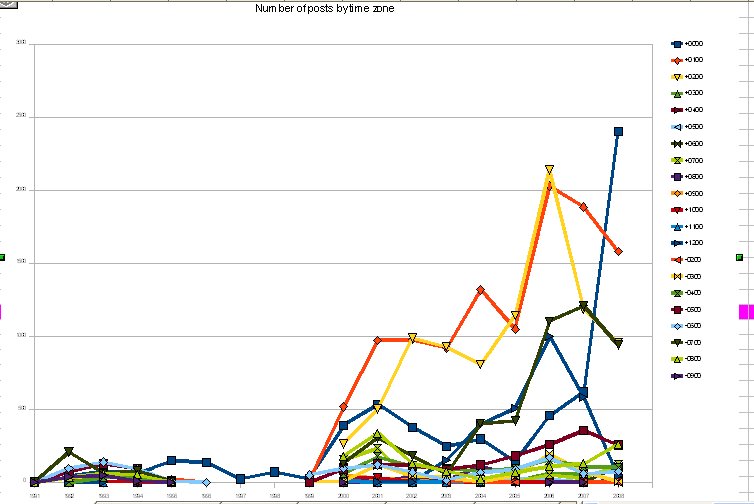
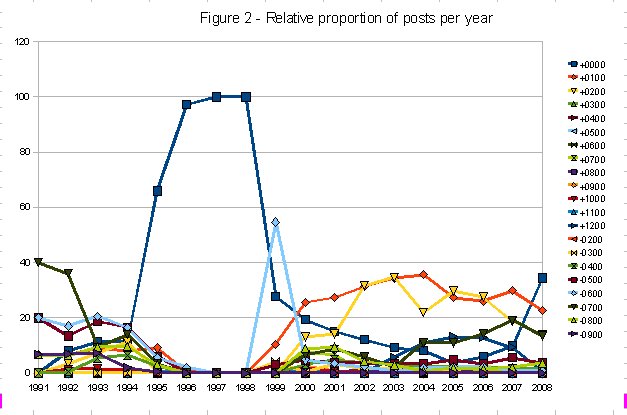
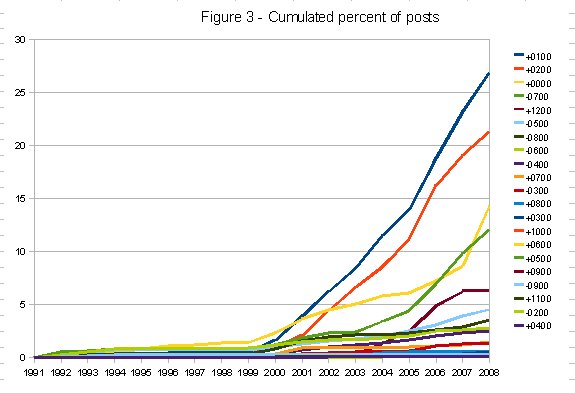


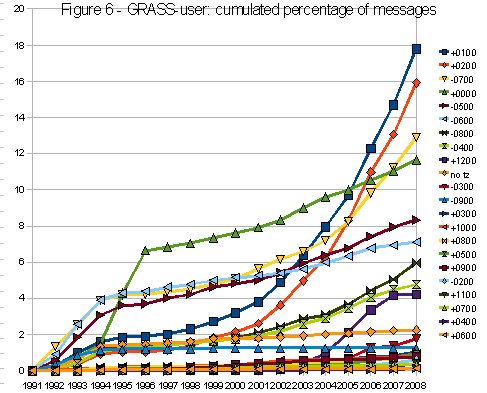
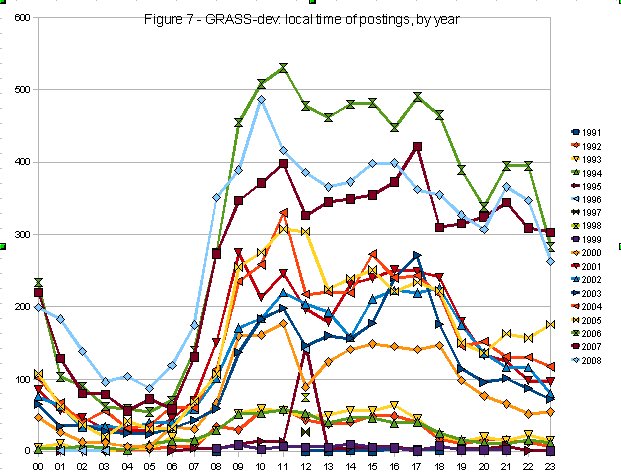
...and what about the contents ?
Another interesting analysis is represented by the text extraction of specific keywords from the message body. While it can be extremely intriguing to build dictionaries of words and expressions used within a mailing list, in the case of the GRASS lists, we decided to focus on GRASS commands. Matrices with the occurrence of GRASS commands by year were generated for both mailing lists. The clear limitation in this type of analysis is that the use of a term is not associated to context. Reference to a specific command may not indicate if this is associated to a coding problem, to issues in use, or to working examples. Another element which is neglected in the analysis is quotation: i.e. the occurrence of a term is counted as long as it appears in the body of a message. At the same time, we think that even a preliminary analysis does provide extremely interesting insight on the bulk of mailing list traffic.
The review of the entries reported by the parser (Figures xx and yy) (DOVE CI PORTA ?)
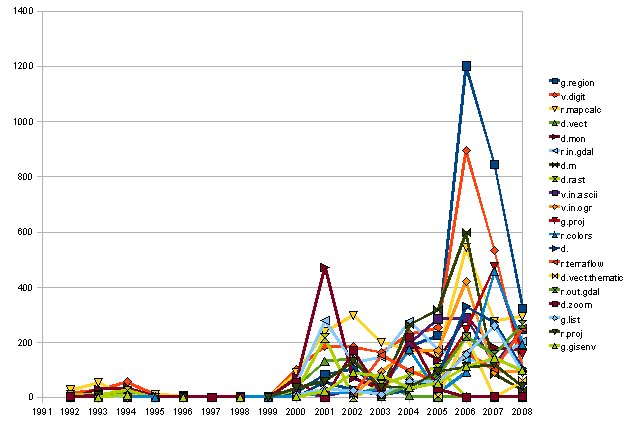

yay... La cosa deve un po' crescere. (AL LIMITE CI LIMITIAMO A SPIEGARE CHE SIAMO CONTENTI DI AVER FATTO UNA PRIMA ESTRAZIONE...)
Reference for details beyond the top 20 entries: worksheets 5 and 6 of ODS file
Trivia
Already in early days GRASS developers were concerned about copyright issues and introduction of non-free code in GRASS. The GRASS FTP site was changed to a 24hs service in September 1992. We remember that there was no WWW at all in those days. First GRASS Linux binaries where announced in February 1994. A first European GRASS FTP mirror site appeared in January 1995. The first internet viruses were discussed in April 1995 and first spam reached the lists in October 1995 (most spam was later manually removed from the list archives by MN). With CERL winding down the development in 1996 due to a governmental decision, the traffic in the developers ist went down to a minimum. The GRASS project returned to real activity in 1997. A first attempt to get GRASS into Debian in March 1998. The new GRASS 4.2.1 package, the first release after 4.1 from CERL became available in January 1998. The license change to GPL was discussed in October 1999. GRASS 5 beta releases came out in October 1999. In 2006 a GRASS Wiki was started (originally TWIKI at https://grass.gdf-hannover.de/wiki/, then in 2006 migrated to Mediawiki, eventually in 2008 to moved to OSGeo at https://grasswiki.osgeo.org/). The mailing lists were migrated in 2007 from ITC-irst, Trento/Italy, to OSGeo, USA.
...
And then..
- RELEASES AND EMAIL HYPE (MN)
- ANNI 90: depression and renewal
- Full steam with OSGeo... GRASS list in the top 10!
Ideas
Consider watching the ML using https://github.com/elationfoundation/openThreads (See: https://www.slideshare.net/apw217/sotm-openthreadsfinal for an introduction to the project)